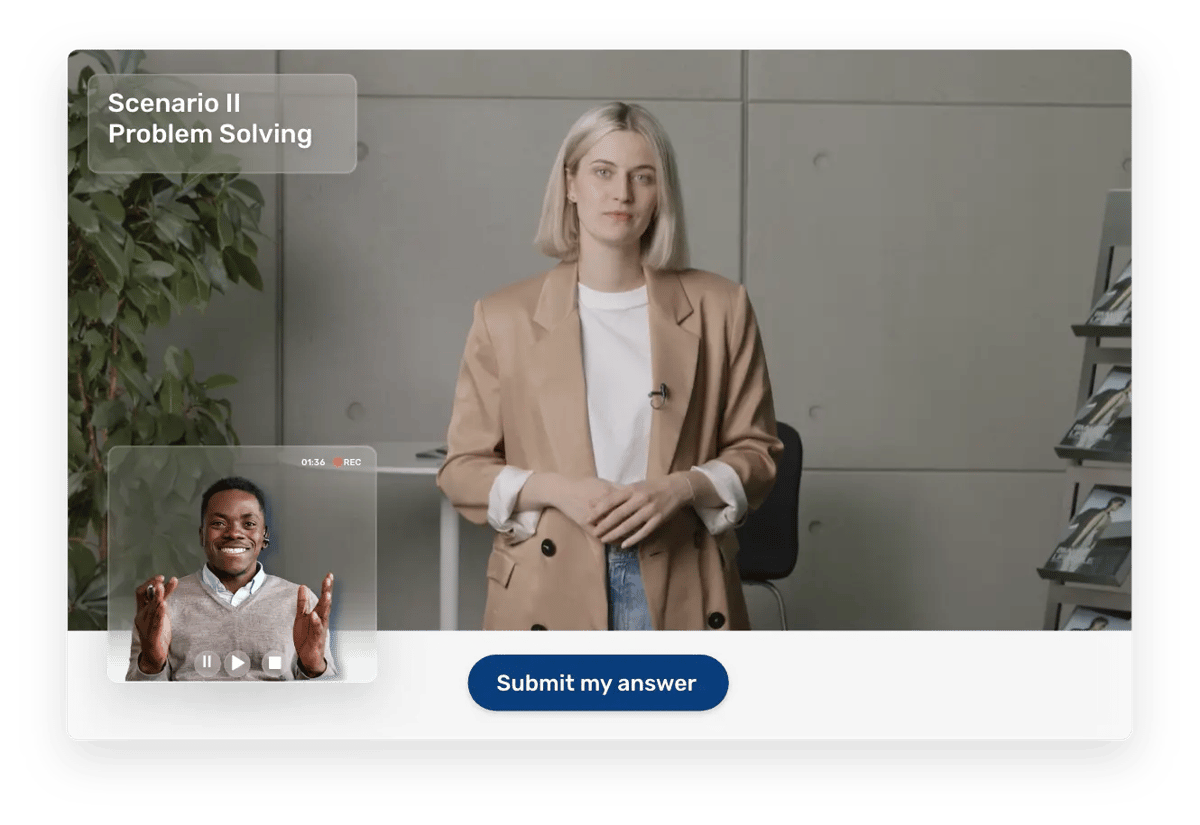In today's dynamic business landscape that is forever evolving (and we are here for it!), pursuing excellence and innovation has become an ever-present challenge for organizations across industries. As companies strive to remain competitive, employee development has emerged as a critical factor in driving long-term growth and success.
Employees are the core of every organization. Happy employees = increased productivity, higher job satisfaction, better retention rates, enhanced creativity and innovation, etc. The list can go on.
Therefore, investing time and resources into employee development is vital to propelling your business towards a more agile, competitive, and future-steady stance. Your employees are your company's greatest assets because it's their abilities, knowledge, and experience that can't always be easily replaced.
A study has found that 74% of workers say that a lack of employee development opportunities is preventing them from reaching their full potential, while another statistic revealed that 58% of employees say that professional development contributes to their job satisfaction.
In this blog post, we will delve into the benefits of AI-driven employee development, equipping every forward-thinking organization on how to leverage AI technology to maximize their team's capabilities.
What's in this post:
- What is employee development?
- What is AI-driven employee development and training?
- What is the employee development process?
- Benefits of AI-driven employee development
What is employee development?
Employee development is the process of enhancing an employee's current competencies and skills while also creating new skills to support the goals and success of the organization.
Employee development helps employees there a new role or department by expanding their skill sets and topic knowledge with the help of their managers and learning and development teams. Employee development also includes development programs that cater to every individual's learning style. This helps employees to identify their knowledge gaps within their strengths to also further their career development.
Statistics by Zavvy reported that between April 2021 and April 2022, the most common reason for employees leaving their positions was a lack of career development and promotion (41%).
What are the four stages of employee development?
The four stages of employee development consist of onboarding, performance, management, and leadership.
-
Onboarding: the onboarding phase is when companies help integrate a new team member into the company's vision and mission, set expectations for what work here versus work there will entail, and introduce the rhythm, culture, and ethos of the company. The goal here is to ensure a smooth transition into the company and set the foundation for their professional journey.
-
Performance: This stage focuses on employee growth through skill development and training. It also focuses on the skill gaps of employees and how Employees take part in various learning opportunities such as workshops, seminars, and training programs to acquire the knowledge and expertise needed to excel in their roles. This stage is crucial for enhancing competencies, expanding their skill set, and staying up-to-date with industry trends.
-
Management: During this stage, employees' accomplishments and growth are consistently assessed, and constructive criticism is given to help them improve. During this stage, which aims to nurture continual growth and maximize potential, performance assessments, and goal-setting discussions are frequent.
-
Career advancement: The final stage focuses on succession planning and professional promotion. Employees are given consideration for higher-level jobs within the company based on their performance, abilities, and potential. When important personnel shift to new positions or leave the organization, succession planning guarantees a seamless transfer of responsibility. This phase promotes sustained employee loyalty and acts as a major success factor for the firm.
LinkedIn reported that 93% of employees are eager to remain with a company if the company invests in their career growth.
What is AI-driven employee development and training?
With all the stages mentioned above, it may seem like a lot of work to maintain a well-balanced and efficient employee development process, but that no longer has to be the case. Artificial intelligence is here to make sure that your employee development and training go smoothly and cater to every single individual.
A survey found that 94% of employees would stay at the company longer if they were offered learning and development programs and opportunities.
AI-driven employee development and training refers to a cutting-edge approach that utilizes AI and machine learning technologies to transform the traditional training methods of nurturing employee skills and knowledge. This innovative strategy harnesses the power of AI tools to enhance the entire training process.
At its core, AI-driven employee development leverages machine learning algorithms to analyze vast amounts of data and gain valuable insights into individual employee learning patterns, strengths, and areas for improvement.
This data-driven approach enables the creation of personalized learning experiences tailored to each employee's unique needs, preferences, and learning style.
In fact, this process can be fun and productive all at once. One amazing benefit of implementing artificial intelligence into any process is its ability to automate tasks. Having AI automate your employee development program, streamlines the training process, freeing up valuable time for trainers and HR professionals to focus on more strategic aspects of employee development.
What is the Employee development process?
Organizations use the employee development process as a planned and purposeful strategy to improve the talents, skills, and knowledge of their employees.
It involves a series of planned activities and initiatives aimed at fostering individual growth and professional advancement. The ultimate goal of an employee development process is to empower employees to reach their full potential, contribute effectively to the organization's success, and remain adaptable in a dynamic business environment.
The process typically begins with assessing individual performance and identifying specific areas for improvement. Based on this assessment, clear and measurable development goals are set for each employee, aligning with their career aspirations and organizational objectives.
Organizations then implement AI-powered learning and development programs to provide employees with targeted opportunities for growth. Employees need ongoing feedback and coaching sessions to help them on their developmental path.
The success of the process is ensured by regular monitoring and evaluation of progress, which also allows for required modifications. A culture of continuous learning is promoted and further motivated by recognizing and rewarding staff accomplishments.
Through this approach, businesses develop a knowledgeable and flexible staff, fostering both individual and collective success in a fast-paced corporate environment.
However, when it comes to the transformation of employee development, AI has played a major role in making training programs more efficient and easier to access for everyone. Not only is it important to know what employee development is, the benefits that it offers are even more important.
Benefits of AI-driven employee development
70% of workers would quit their present employer for one that prioritizes learning and development for staff members.
The statistic above just proves why it is important to consider the benefits of AI-driven employee development.
1. Personalized learning experiences
When it comes to employee development, providing employees with personalized learning experiences is one of the best things you can do because everyone's learning journey is different and no one works the same. Therefore, attempting the traditional training methods with the one-size-fits-all approach can backfire as these types of training programs struggle to accommodate the unique learning styles of each learner. This can lead to suboptimal learning outcomes and disengagement.
58% of all employees prefer to learn at their own pace.
However, with artificial intelligence at the helm, organizations can offer tailored learning experiences that take into account an employee's preferred learning style, past learning outcomes, and individual skills gaps.
These personalized learning experiences also allow employees to learn and train in a safe space that does not have external interference where the only competition is yourself.
Therefore, by creating content that is based on each learner's abilities and competencies, AI can readily adapt to their specific demands. This makes it possible for each employee to receive tailored material at the right time.
2. Efficient Skill gap analysis
By utilizing its data processing skills and sophisticated algorithms, AI speeds the process of identifying skill gaps in staff development. AI swiftly determines the skills gaps between an individual's existing talents and the skills necessary for their function by compiling and analyzing enormous volumes of employee data.
This data is compared to predetermined standards and industry trends to provide detailed skill gap reports for each employee. AI's ability will then identify knowledge gaps and inform each employee where their strengths are, and give recommendations for skills development.
Simply said, the AI analysis serves as a basis for tailored learning paths by suggesting chances for growth and training that are specifically aimed at closing the gaps that have been detected and provides more accurate assessments of who each employee is and what they need in order to succeed.
3. Promoting transparency
Artificial intelligence encourages openness and transparency in employee development by offering unbiased and fact-based insights throughout the entire process. When transforming employee training and development, AI-powered systems help to eliminate subjectivity and prejudice by basing the performance evaluation.
Moreover, AI-powered systems eliminate subjectivity and bias by basing performance evaluations, skill assessments, and training progress on objective measures. Employees can learn their strengths, shortcomings, and potential growth areas thanks to the real-time feedback and performance data that is available to them.
Transparency encourages open communication between staff members and management, which results in more insightful discussions regarding professional development and skill improvement.
Additionally, AI-driven systems frequently provide insight into existing learning materials and carer progression possibilities, allowing employees to actively participate in their professional growth and eventually develop an organizational culture that values fairness, responsibility, and trust.
4. Real-time feedback
One of the key benefits of AI-driven employee training and development is the opportunity for employees to receive instant feedback as well as personalized feedback.
As aforementioned, employees can keep track of their learning and training progress, and see what comes next for them, and where they can continue to improve. With the help of AI, employees are able to make quick modifications in their training and progress due to the rapid feedback, which improves their skill growth, and work performance.
Furthermore, managers and HR specialists can use real-time feedback to resolve problems quickly, provide assistance, and customize learning opportunities to each employee's particular requirements.
AI-powered real-time feedback promotes a culture of continuous development, increases employee engagement, and helps a business succeed overall by developing a highly qualified and driven staff.
5. Data-driven insights
Everything is about data. The more data you have, the better training you can build which inevitably leads to faster growth and success. However, analyzing data can be incredibly time-consuming, but the generation of data-driven insights with the help of AI for employee development brings significant advantages to organizations.
AI delivers useful and unbiased information on individual performance, learning trends, and skill gaps by evaluating enormous volumes of employee data.
These insights enable HR specialists and managers to plan individualized learning pathways, establish growth objectives, and allocate resources wisely.
Furthermore, data-driven insights enable the execution of tailored interventions to raise staff productivity, retention, and performance by identifying trends and patterns throughout the company.
Fundamentally, AI's data-driven approach to staff development maximizes training expenditures, improves decision-making, and promotes a culture of continuous improvement, eventually resulting in a positive impact on the long-term performance of the business.
6. Enhanced employee engagement
By providing individualized and engaging experiences, artificial intelligence plays a crucial role in fostering employee engagement for employee growth.
Along with AI customizing learning journeys, and offering real-time feedback to fit the individual requirements and preferences of each employee by evaluating large volumes of employee data, AI ensures that each employee stays motivated and engaged throughout their work days in the company.
The interactive and gamification components built into AI-powered systems increase engagement, making learning fun and inspiring. Additionally, chatbots and virtual assistants powered by AI simplify communication, promoting seamless cooperation and assistance.
In addition to empowering employees to take control of their development journeys, this personalized, data-driven, and interactive approach also fosters a supportive work environment, which ultimately results in greater job satisfaction, increased productivity, and a more dedicated and engaged workforce.
7. Cost-effectiveness
Did you know that the average cost of training and development for each employee, according to The Association of Talent Development, is $1,251?
Of course, this value may change depending on company size and the type of training implemented, but those costs can easily be cut down in the long run by investing in high-quality AI-driven employee development.
Employee training is now more efficient and less expensive thanks to AI learning technologies. By adjusting the training material and delivery to meet the requirements and learning preferences of each employee, these solutions offer a personalized learning experience.
Scalability and accessibility allow AI-powered systems to support a large number of users without adding extra expenses for physical resources or paying outside educators. Access to a variety of educational materials and the seamless integration of micro-learning modules into regular work activities support continuous learning.
Additionally, AI systems that give real-time feedback and assessments enable workers to monitor their development and pinpoint opportunities for growth. Adaptive learning routes optimize the training experience by changing the content based on performance.
Virtual assistants powered by AI also improve learning by offering prompt solutions and direction, negating the need for human instructors or support personnel. By utilizing AI learning technologies and providing individualized and efficient staff training, organizations may reduce the expenses associated with physical resources, logistics, and printed materials.

You no longer need to go searching for a platform that includes all of those benefits for your employee development program. Retorio's behavioral intelligence platform has it covered.
With Retorio's learning and development programs, personalized training, unbiased real-time feedback, and guaranteed efficiency in retaining talent, in the long run, can all be discovered within minutes. Gone are the days when training programs are boring and tedious because, with Retorio's AI-simulated role-play scenarios, your employees become immersed in various real-life situations that keep the learning journey engaging, productive, and enjoyable. Motivation is no longer a factor, and employees can practice in a physiologically safe space, anywhere in world, with 24/7 access.
So...why not start reaping the benefits yourself? It's never too late to incorporate AI into your employee development program, and for long-term success and positive growth in your team and company, Retorio is all set to help you get started right away!
Click on the button below to begin!
FAQ
AI increases worker efficiency by simplifying procedures and offering insightful data. AI performs tedious jobs through automation, giving staff more time to concentrate on more important and creative duties. It also does extensive data analysis to provide data-driven insights that support rational decision-making. Employee training will be customized thanks to AI's capacity to customize learning experiences, increasing skill growth and productivity. AI-powered communication solutions also improve cooperation and rapid access to information, which further boosts efficiency at work.
By increasing many facets of the training process, artificial intelligence (AI) may considerably increase learning and development (L&D) efforts. By adapting information to individual requirements and tastes, AI-driven systems may customize learning experiences, boosting engagement and memory retention. Additionally, the data analytics capabilities of AI enable L&D professionals to develop more efficient training programs and pinpoint skill shortages by offering insightful data on employee performance and learning trends. Chatbots and virtual assistants powered by AI also make communication simple, offer quick access to information and help, and further improve learning. Overall, AI's contributions to L&D result in more effective training programs that are also more efficient, which supports a trained and empowered workforce.
Employees may improve both personally and professionally with the use of an effective instrument called an employee development plan. Plans for career development assist teams in achieving organizational objectives and maintaining their motivation, effectiveness, and success. Plans with specific actions enable workers to hone abilities, increase productivity, discover new things, and broaden their knowledge and networks.





